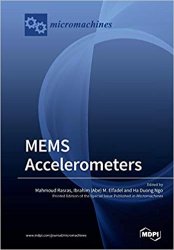 Название: MEMS Accelerometers
Название: MEMS AccelerometersАвтор: Mahmoud Rasras, Ibrahim (Abe) M Elfadel, Ha Duong Ngo
Издательство: Mdpi AG
Год: 2019
Формат: PDF
Размер: 36 Мб
Язык: английский / English
Micro-electro-mechanical system (MEMS) devices are widely used for inertia, pressure, and ultrasound sensing applications. Research on integrated MEMS technology has undergone extensive development driven by the requirements of a compact footprint, low cost, and increased functionality. Accelerometers are among the most widely used sensors implemented in MEMS technology. MEMS accelerometers are showing a growing presence in almost all industries ranging from automotive to medical. A traditional MEMS accelerometer employs a proof mass suspended to springs, which displaces in response to an external acceleration. A single proof mass can be used for one- or multi-axis sensing.
A variety of transduction mechanisms have been used to detect the displacement. They include capacitive, piezoelectric, thermal, tunneling, and optical mechanisms. Capacitive accelerometers are widely used due to their DC measurement interface, thermal stability, reliability, and low cost. However, they are sensitive to electromagnetic field interferences and have poor performance for high-end applications (e.g., precise attitude control for the satellite). Over the past three decades, steady progress has been made in the area of optical accelerometers for high-performance and high-sensitivity applications but several challenges are still to be tackled by researchers and engineers to fully realize opto-mechanical accelerometers, such as chip-scale integration, scaling, low bandwidth, etc.